Content
- The clinical significance of the anatomical and physiological characteristics of the cardiovascular system in children
- Placental circulation
- Cardiovascular system of the newborn
- Blood circulation of the newborn
- Intensive supply of the brain with blood
- Turning and moving the heart
- Heart rate
- Arterial pressure
- Age features of the cardiovascular system of preschoolers and schoolchildren
- Cardiovascular system of adolescents
- Video about AFO CCC
AFO SSS (anatomical and physiological features of cardio-vascular system) in children differ as the child of the corresponding age develops. During the period of intrauterine formation of the fetus, the principle of the relationship between the blood circulation of the mother and the baby is preserved. After the birth of a child, the processes of active development of the heart and blood vessels are launched.
In preschoolers and children studying in primary school, the rate of growth of the heart muscle slows down, but at the same time there is an active formation of arteries, veins and arterioles. With the onset of the puberty phase, the growth process of the entire cardiovascular system of the child is activated.
The clinical significance of the anatomical and physiological characteristics of the cardiovascular system in children
AFO SSS play an important role in maintaining the stable vital activity of the child's body.
The clinical significance of the anatomical and physiological characteristics of the cardiovascular system in children is as follows:
- transportation of nutrients and oxygen molecules to internal organs, as well as to all body tissues;
- elimination of harmful substances that were formed in the body at the end of metabolic processes;
- maintaining the stable operation of all life support systems.
This clinical significance of the anatomical and physiological features of the cardiovascular system of children is provided only under conditions of synchronous work of the respiratory, excretion and digestion organs. The improvement of the functional activity of these organs occurs gradually as the child grows up.
Placental circulation
AFO CVS in children at the stage of intrauterine development is characterized by the gradual formation of the tissues of the heart and blood vessels. The laying of the foundations for the formation of the heart muscle begins from the 2nd week of the embryo's life. Over the next 3 weeks, from the plate, which is located between the body and the head, the heart is formed, containing all the departments and structural elements necessary for its contractile activities.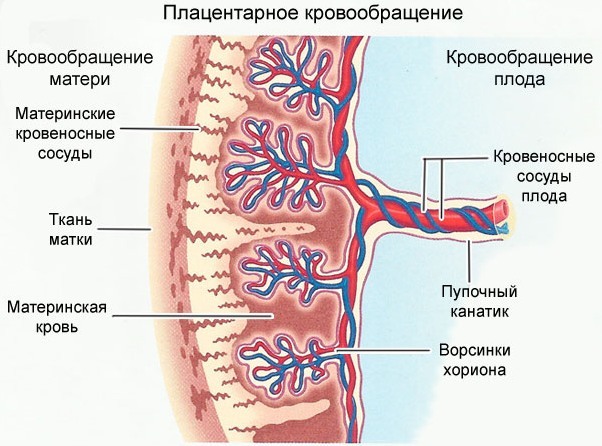
Conditions begin to be created that are important for ensuring further blood supply to the tissues of the fetus. During the first 6 weeks, the heart muscle of the embryo includes 3 chambers, and the subsequent formation of 4 chambers occurs due to the physiological separation of the atria.
Immediately after the completion of the stage of formation of the 4th chamber, the natural process of separation of the heart muscles on the left and right sides, the formation of valves that provide venous and arterial blood circulation. The conduction system of the heart muscle begins to develop almost immediately.
The formation of key arteries occurs from the 2nd week of intrauterine life of the embryo. During this period, the oxygen-rich blood of the pregnant woman flows through the placental barrier towards the umbilical vein, and then saturates the fetal tissue. Part of this blood enters the liver, and a significant volume of the bloodstream moves to the vena cava.
The blood entering the inferior vena cava is redirected to the right atrium of the fetus. In the same part of the heart muscle, blood is poured, which was in the superior vena cava. A distinctive feature of the placental circulation is that the blood directed from the inferior and superior vena cava does not mix with each other. Blood coming from the inferior vena cava passes through the oval window, enters the left side of the heart and saturates the aorta.
Blood is poured from the superior vena cava, which contains a minimum amount of oxygen. It enters the right atrium, then into the right ventricle and the upper part of the pulmonary artery, from which it is redirected to the aorta, where it mixes with blood from the left ventricle.
A small volume of blood is sent to the tissues of the fetal lungs, from which it returns to the left atrium, and then mixes with the blood that has passed through the oval window of the heart. The minimum amount of blood continues to circulate through the pulmonary circulation of the fetus until the baby is born, when the first breath is taken.
Due to this, at all stages of intrauterine development, the liver and brain tissues of the child receive the maximum amount of oxygen, which ensures the intensive formation of cells of these organs. Immediately after the birth of the baby, the umbilical vessels and the ductus venosus empty, quickly begin to overgrow, and then form a round ligament of liver tissue.
Cardiovascular system of the newborn
The cardiovascular system of a newborn is characterized by a number of physiological differences that gradually disappear at different stages of the child's physical development.
Blood circulation of the newborn
The coronary vessels of a newborn baby are distributed in a loose pattern. A sufficiently large lumen remains between the walls of arteries and veins, and the density of their inner side remains extremely low.
At this stage of the physical development of the newborn's circulatory system, conditions are created for an increased predisposition to dystrophic and inflammatory processes in the structure of blood vessels. This situation is due to increased vascularization and too loose tissue that surrounds the vascular tissue.
AFO CVS in newborns is characterized not only by the presence of a very wide lumen between the walls of blood vessels, but also by the same internal parameters of veins and arteries. At the same time, the blood vessels of the latter type are distinguished by a more elastic structure, the ability to adapt to stress loads.
Newborn children have much less than adults:
- general blood flow rate;
- peripheral resistance;
- blood pressure indicators.
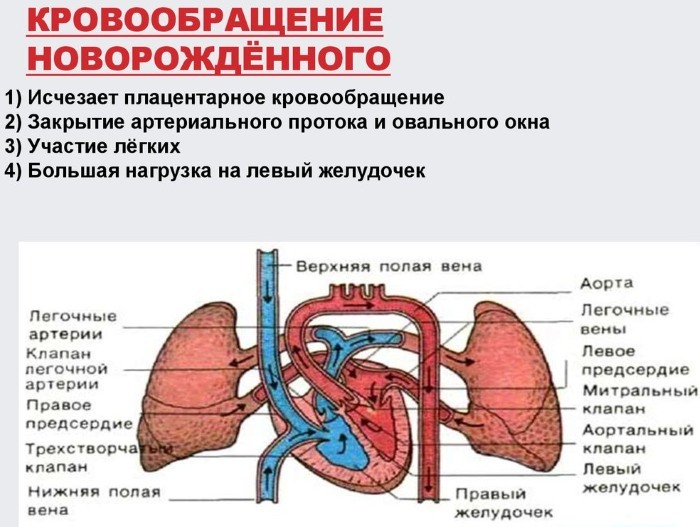 In newborns, the capillaries, which are directly involved in the blood circulation process, are well developed. In the linear field of view, there are on average 6 to 8 blood vessels of this type. For example, in adults, this indicator is 10 units. A distinctive feature of the capillaries of a newborn baby is their irregular shape.
In newborns, the capillaries, which are directly involved in the blood circulation process, are well developed. In the linear field of view, there are on average 6 to 8 blood vessels of this type. For example, in adults, this indicator is 10 units. A distinctive feature of the capillaries of a newborn baby is their irregular shape.
All vessels have too short a body, and are also convoluted in different directions. The subcapillary plexuses of the venous type, which are also considered part of the general circulatory system, are located superficially, clearly visible under the layer of the child's skin.
At the end of the neonatal period, the child's capillaries take on a pronounced hairpin shape, which is considered anatomically correct. Subcapillary plexuses of the venous type are located in the deeper layers of soft tissues and become inaccessible to their determination by visual examination of the child's body.
Despite these changes in the circulatory system of children, the permeability of their capillaries remains higher than that of a child over 10 years old or an adult.
Intensive supply of the brain with blood
An intensive supply of blood to the brain is carried out using 2 carotid arteries, as well as a similar number of vertebral arteries. After the required amount of oxygen and nutrients has been delivered to these blood vessels, blood outflows through the 2nd jugular veins.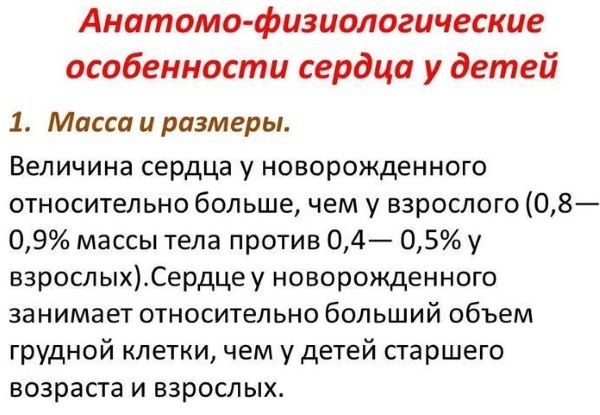
The resting newborn brain tissue consumes about 15% of the total blood volume. At the same time, his cells need 20-25% of oxygen, which enters the child's body during the work of the respiratory system.
The carotid arteries, which act as the main transport routes for oxygen and nutrients, create a carotid pool of intense blood supply. These vessels originate in the chest cavity. The right artery departs from the brachiocephalic trunk, and the left in the direction of the aortic arch. The carotid arteries account for 70 to 85% of the total load to ensure a full supply of the child's brain with a sufficient volume of blood.
The functional purpose of the vertebral arteries is to form the vertebrobasilar basin with saturation of the following segments of the newborn's brain:
- cervical spinal cord;
- medulla;
- cerebellum.
The vertebral arteries approach the tissues of the brain of a newborn baby inside the bone canal, which was formed from the transverse processes of the vertebrae of the cervical spine. Blood vessels of this type originate inside the chest.
Turning and moving the heart
Newborn babies have a rounded heart shape, which retains these parameters until the child reaches the age of 6 years. Upon reaching this period of physical development, the heart muscle begins to gradually acquire the shape of an oval, resembling an organ of an adult. In newborns, the heart is in a horizontal position, on a raised diaphragm.
The right ventricle is located in close proximity to the anterior chest wall. This part of the baby's heart muscle takes part in the formation of the apical impulse of the heart. The horizontal position of the heart is maintained throughout the entire neonatal period. Upon reaching 2-3 years, a gradual movement of the heart muscle inside the chest occurs.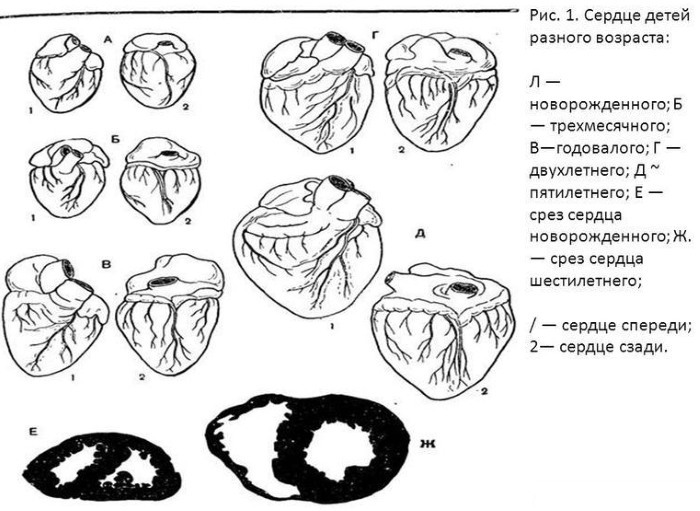
When children reach the age of 3-4 years, active processes of growth of their bones and body muscles are started. There is a faster formation of the entire musculoskeletal system, the growing up child. During this period, children experience a significant increase in the size of the chest. At the same moment, the diaphragm, on which the heart is located, acquires a lower position. At the same time, the physiological size of the thymus gland decreases.
Under the influence of these factors, the child's heart gradually acquires an oblique position, turning around its axis. During the movement of the heart muscle, its left ventricle is in front. Upon completion of the process of turning and moving the heart, its interventricular septum is in contact with the anterior chest wall. At this stage, the impulse begins to form the left ventricle.
Heart rate
In children of newborn age, the pulse rate reaches values of 140-160 beats per minute. As the baby's cardiovascular system develops, this indicator gradually changes downward. For children who have reached the age of 12 months. the rate of contraction of the pulse is from 110 to 140 beats per minute.
In a child who has congenital heart defects, this indicator can differ significantly. For children of this category, the pulse rate is determined individually by a pediatric cardiologist based on the results of a comprehensive examination of the infant's cardiovascular system.
Arterial pressure
In newborns, blood pressure is significantly lower than in adults or adolescents. The presence of this physiological feature of the body of infants is explained by the fact that their blood vessels have a wider gap between the walls.
As children grow older, blood pressure gradually increases. The child's blood pressure rate is calculated using a special formula that takes into account the age of the subject. The table below describes the procedure for determining blood pressure indicators in children of different age categories.
| Child's age | The procedure for determining the indicators of the norm in children of different age groups |
| Children under the age of 12 months. | The initial indicator of systolic pressure is equal to the coefficient 75 + n. The Latin letter "n" is the full age of the newborn in months. The infant's diastolic pressure should be 10 units less than the systolic value, which was determined from the results of mathematical calculations using the above formula. |
| For children from 1 year old to puberty. | The systolic pressure of the arteries is determined using the formula 90 + 2xn. The rate of systolic blood pressure is calculated by the formula 60 + 2xn. In this case, the Latin letter "n" is the child's full age in years. |
During the measurement of blood pressure indicators in newborns, it is taken into account general health of the child, functional activity of the heart and all life support systems organism.
Age features of the cardiovascular system of preschoolers and schoolchildren
AFO SSS in preschool children and primary school students has insignificant differences:
- The pulse rate in a child who is 5 years old is within 100 beats per minute. This is an indicator of the norm for preschool children who do not have congenital or acquired diseases of the heart, blood vessels.
- For a schoolchild, whose age is from 5 to 10 years old, the rate of pulse rate is from 80 to 90 beats per minute.
- As the child grows up, as well as by the beginning of the active phase of puberty, the functional activity of the heart changes. For a 15-year-old schoolchild, the heart rate rate is 80 beats per minute.
 In preschoolers under the age of 5 years, there is an active development of the muscle layer of the walls of blood vessels. Arteries and arterioles are most actively formed. In children aged 5 to 8 years, there is a uniform development of the inner membranes of blood vessels of all types. There is an active preparation of the child's body for the phase of puberty.
In preschoolers under the age of 5 years, there is an active development of the muscle layer of the walls of blood vessels. Arteries and arterioles are most actively formed. In children aged 5 to 8 years, there is a uniform development of the inner membranes of blood vessels of all types. There is an active preparation of the child's body for the phase of puberty.
By the age of 12, the general structure of the vascular system of a child is exactly the same as that of an adult. Accelerated rates of physiological development of blood vessels in preschool and school children are necessary for the normal functioning of the whole body during puberty.
In children of preschool and school age, the gap between the walls of blood vessels is wider than in adolescents and adults. The younger the child, the greater the distance between the inner layer of blood vessels. During this period of development of the child's body, the width of the arteries completely coincides with the lumen of the walls of the veins. The anatomical relationship between the internal parameters of these blood vessels corresponds to a ratio of 1 to 1.
As children of preschool and school age grow up, there is a gradual expansion of the venous bed. In a 16-year-old child, the ratio of the internal lumen of the arteries to the parameters of the venous vessels is at the level of 1 to 2. At all stages of the formation of the child's body, the walls of the arteries and arterioles retain increased elasticity. At the same time, the venous vessels are distinguished by the presence of a denser muscle layer.
Cardiovascular system of adolescents
AFO CVS in adolescent children is distinguished by the rate of intensive growth of the heart muscle and great vessels. The period of puberty is accompanied by the rapid development of the internal organs of the child, whose tissues need a more active blood supply, providing an additional volume of oxygen and nutrients.
At this age, most children have a mismatch in the growth rate of the heart and the rest of the body. In a teenage child, the ratio of the working volume of the heart muscle in relation to the total mass is 90%. At the same time, in an adult, this indicator is at the level of 60%.
A distinctive feature of the development of the cardiovascular system in adolescent children is the discrepancy between the growth rates of its individual elements. During puberty, the mass of the heart muscle increases several times faster than the development of the great vessels, which provide stable blood circulation throughout the body.
In this regard, there is an increase in peripheral blood flow resistance. The result of this physiological process is the formation of a hypertrophic heart, which is diagnosed in most adolescents. In children who have evolutionary deviations in the development of the heart muscle, sympathetic regulation of its functions is observed.
There are the following physiological features of the cardiovascular system in adolescent children:
- good conductivity of blood vessels, which are in the final phase of their growth and formation;
- excellent blood supply to the tissues of the heart muscle;
- increased need for additional oxygen;
- there is a significantly smaller volume of blood, which is distributed through the circulatory system with each contraction of the heart muscle;
- a high indicator of heart endurance, which is achieved due to the fact that its volume prevails over the total body weight;
- the presence of physiological tachycardia, which occurs due to the need for cells in large volumes of air (in in this case, the child's body is trying to provide all the tissues of internal organs with an additional amount oxygen);
- low blood pressure;
- less pronounced resistance of peripheral blood vessels;
- uneven development of the tissues of the heart muscle and the walls of blood vessels.
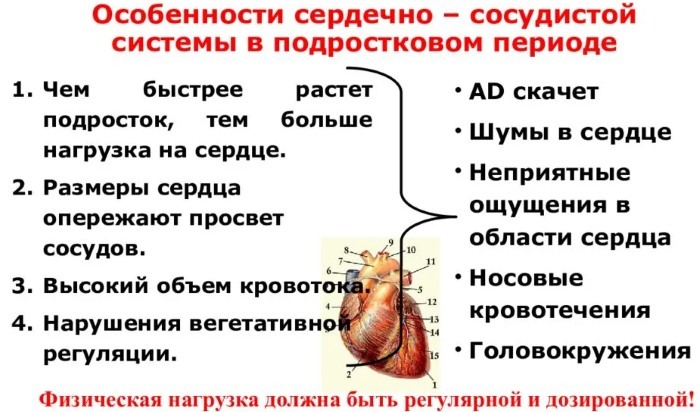 Adolescent children are at increased risk of cardiovascular disorders. As the period of puberty is completed, the functions of the heart gradually normalize, blood pressure indicators, symptoms of physiological tachycardia disappear, as well as other pathological signs.
Adolescent children are at increased risk of cardiovascular disorders. As the period of puberty is completed, the functions of the heart gradually normalize, blood pressure indicators, symptoms of physiological tachycardia disappear, as well as other pathological signs.
Adolescents with age-related disorders in the work of the cardiovascular system need supportive therapy, which includes taking vitamin and mineral complexes, drugs that improve intracellular metabolism substances. By the age of 17, the total weight of a child's heart increases 10 times.
AFO CVS (anatomical and physiological features of the cardiovascular system) in children of different age groups change as their body develops. A newborn child has a frequent reduction in pulse rate, lower blood pressure, active formation of the inner layer of the walls of blood vessels.
During the period of intrauterine development, the blood supply of the baby is provided with the direct participation of the placenta. On the 2nd and 3rd trimester of fetal formation, the most active blood circulation is noted in the tissues of the brain, heart and liver.
The smallest volume of blood flows to the lower extremities. At preschool and school age, there is an active development of all parts of the cardiovascular system, and by the age of 12 children have fully formed veins and arteries that are ready for the physiological stress of the sexual stage ripening.
Video about AFO CCC
Anatomical and physiological features of the cardiovascular system in children:



